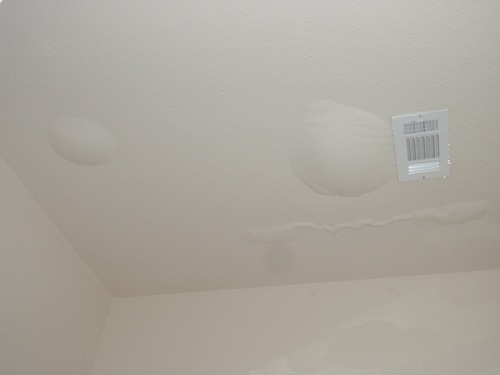There are a number of signs that you may have water damage in your ceiling. Some of the most common signs include:
- Discoloration or stains: Water damage can cause discoloration or stains on your ceiling. These stains can be any color, but they are often brown, yellow, or rust-colored.
- Peeling paint or wallpaper: Water damage can cause paint or wallpaper to peel or bubble.
- Musty smell: Mold and mildew can grow in water-damaged areas, and they can produce a musty smell.
- Sagging or bowing: Water damage can cause your ceiling to sag or bow.
- Cracks or holes: Water damage can cause cracks or holes in your ceiling.

What to Do
If you see any of these signs, it’s important to take action immediately. Here are some steps you can take:
- Identify the source of the leak. Once you know where the leak is coming from, you can take steps to fix it.
- Clean up the water damage. Use a wet/dry vacuum to remove any standing water. Then, use a mild detergent and water to clean the area.
- Dry the affected area. Allow the area to dry completely before moving on to the next step.
- Repair the damage. Once the area is dry, you can repair any damage that has been caused by the water damage.
Preventing Water Damage
The best way to prevent water damage in your ceiling is to take steps to prevent leaks. Here are a few tips:
- Inspect your roof regularly for damage.
- Check your gutters and downspouts for clogs.
- Fix any leaky faucets or pipes.
- Install a sump pump in your basement.
Conclusion
Water damage in your ceiling can be a serious problem. If you think you may have water damage, it’s important to take action immediately to prevent further damage. By following the steps above, you can help to prevent water damage and keep your home safe and healthy.
Read too: How To Paint A Basement Ceiling
Additional Information
In addition to the signs listed above, there are a few other things you can look for that may indicate water damage in your ceiling. For example, you may notice that your ceiling is cold to the touch, or that there is condensation on the ceiling. If you see any of these signs, it’s a good idea to have a professional inspect your ceiling for water damage.
Water damage in your ceiling can be a costly and time-consuming problem to repair. By taking steps to prevent water damage, you can help to protect your home and your wallet.tunesharemore_vert